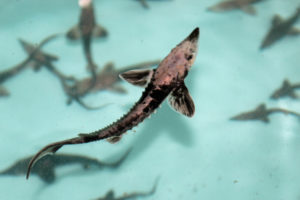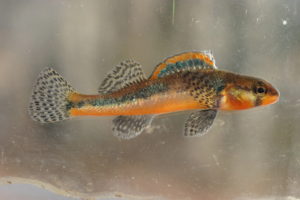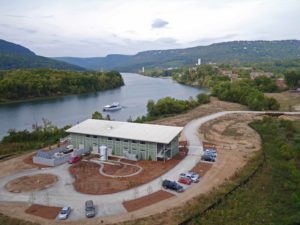 Dr. Bernie Kuhajda joined the Tennessee Aquarium Conservation Institute staff in May 2012 after 25 years at the University of Alabama, where he managed a museum collection of one million specimens of preserved fishes from all around the world. Though his studies of fishes and other aquatic organisms have taken him around the United States, Mexico, and Central Asia, his particular expertise is surveying and monitoring threatened and endangered species from aquatic systems in the Southeast, in part to help evaluate the effectiveness of conservation programs. He currently teaches weekend courses at the University of Alabama Gadsden Campus and on the main campus in Tuscaloosa every summer. He serves on multiple USFWS Recovery Teams/Groups for endangered and threatened species.
Dr. Bernie Kuhajda joined the Tennessee Aquarium Conservation Institute staff in May 2012 after 25 years at the University of Alabama, where he managed a museum collection of one million specimens of preserved fishes from all around the world. Though his studies of fishes and other aquatic organisms have taken him around the United States, Mexico, and Central Asia, his particular expertise is surveying and monitoring threatened and endangered species from aquatic systems in the Southeast, in part to help evaluate the effectiveness of conservation programs. He currently teaches weekend courses at the University of Alabama Gadsden Campus and on the main campus in Tuscaloosa every summer. He serves on multiple USFWS Recovery Teams/Groups for endangered and threatened species.
Imagine possessing untold wealth but lacking the means to keep it safe. That is the broad-strokes reality faced by those of us who work to protect the Southeast’s rich aquatic biodiversity.
Our waterways are home to an incredible natural profusion, one that is unrivaled in the temperate world. More than 1,400 aquatic species reside in waterways within a 500-mile radius of the Tennessee Aquarium’s home in Chattanooga, including about three-quarters (73.1 percent) of all native fish species in the United States. More than 90 percent of all American mussels and crayfish species live within that same area, as do 80 percent of North America’s salamander species and half of its turtle species.
From massive sturgeon in the Coosa, Cumberland and Tennessee Rivers to swarms of colorful darters and minnows in isolated mountain streams, the inhabitants of our underwater rain forest are being imperiled on multiple fronts due to disproportionate federal funding, encroachment from human development, and a general lack of public awareness of the menagerie swimming just below the surface.

As a freshwater scientist, it seems like every student with an interest in biology wants to grow up to work with marine mammals or sharks. While those animals need protection too, we need to help spark a passion for the dazzling darters and topminnows that thrive in southeastern waters.

In part, the problem is bureaucratic. Especially compared to western states, the Southeast has relatively few protected lands, and the absence of buffer zones and heavy development around our region’s waterways places already-fragile freshwater ecosystems at even greater risk. Loss of habitat in the Southeast further endangers freshwater species, which already face extinction rates three to five times higher than those of terrestrial and marine animals.
But funding to protect our biological treasures simply isn’t being allocated proportionately. In part, this imbalance is rooted in a lack of public interest in, and support of, freshwater habitats relative to marine and terrestrial habitats.
To see this disparity written bold, you only have to look at the budgets for federal spending to protect Southeastern freshwater species. The amount devoted annually to our region is drastically out of sync with its incredible diversity.

Between 2012 and 2014, total expenditure on programs to study threatened and endangered freshwater fishes in the Southeast averaged $6.2 million. During the same period, just 12 species outside the region — most of them game fish such as salmon and trout — received a combined $636 million in funding. To present that imbalance even more plainly, at current levels of support, it would take more than a century for the Southeast to achieve the same amount of funding received in a single year by just a dozen species.
Until recently, our work to offset the Southeast’s ecological crisis was further complicated by conservation resources that were few and — quite literally — far between. Much of the research at the Tennessee Aquarium Conservation Institute (TNACI) was conducted in far-flung locations, some of them almost an hour apart. Working in separate facilities slowed our conservation efforts and made it more difficult to collaborate.
The 14,000-square-foot building is located on the banks of the Tennessee River just downstream from downtown Chattanooga. It was designed from the ground up to be environmentally conscious, from the use of rainfall catchment systems to a site development plan that helped revitalize a nearby wetland.

Within its walls our staff of conservation scientists, as well as visiting experts, will have access to dedicated genetics and morphology labs, which will greatly enhance collection of data that informs conservation management decisions. The site also serves as the new home for our long-standing propagation programs for Lake Sturgeon and Southern Appalachian Brook Trout, which were formerly housed in separate locations.
Our new biological field station functions as a convening point for a variety of research efforts, both new and ongoing. These include recently funded population genetics analyses of the federally endangered Laurel Dace and Cumberland Darter. The respective habitats for these endangered species have shrunk to a handful of streams on Walden Ridge (at the eastern edge of the Cumberland Plateau) and a limited stretch of the Cumberland River (in Kentucky and Tennessee). In the case of the Laurel Dace, we may have to resort to collecting an ark population if our findings are as grim as what we suspect. The genetically distinct southern population has drastically declined as a result of sedimentation choking the few remaining native streams where they are still found. (This year’s exceptional drought has only served to exacerbate their fragile status.)
We remain somewhat hopeful, however, because one of the greatest assets of the new facility is its square footage. We now have the room to take in these animals if an ark population is warranted.
And, we now have the space to centralize our work, which already is helping to ease the logistics of field research. In particular, it has streamlined a population survey I initiated in September of the Blue Shiner, the Cahaba Shiner, the Goldline Darter, the Rush Darter, the Vermillion Darter and the Watercress Darter, all threatened and endangered species found in the Mobile Basin.
TNACI’s new facility marks a significant step in our ongoing effort to protect our natural heritage and safeguard the Southeast’s incredible aquatic biodiversity. By acting as a hub for freshwater conservation research in the lab and in the field, we can help ensure that future generations aren’t robbed of the opportunity to enjoy and appreciate those ecological riches.
